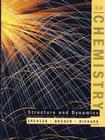化學(xué)
出版時(shí)間:2006-12 出版社:吉林長(zhǎng)白山 作者:Spencer, James N.; Bodner, George M.; Rickard, Lyman H. 頁(yè)數(shù):735
內(nèi)容概要
Promote a spirit of scientific discovery New scientific discoveries do not usually begin with models; they begin with data and a spirit of intellectual curiosity. In much the same way, Spencer, Bodner, and Rickard's Chemistry: Structure & Dynamics, Third Edition presents data, and challenges students to derive the models. Built on the recommendations of the American Chemical Society's Task Force on the General Chemistry Curriculum, this innovative approach helps students get a feel for how chemists approach problems in the real world.
書籍目錄
Chapter 1. Elements and Compounds. 1.1 Chemistry: A Definition. 1.2 Elements, Compounds, and Mixtures. 1.3 Atomic Symbols. 1.4 Chemical Formulas. 1.5 Evidence for the Existence of Atoms. 1.6 The Structure of Atoms. 1.7 Atomic Number and Mass Number. 1.8 Isotopes. 1.9 The Difference between Atoms and Ions. 1.10 Polyatomic Ions. 1.11 Predicting the Formulas of Ionic Compounds. 1.12 The Periodic Table. 1.13 The Macroscopic, Atomic, and Symbolic Worlds of Chemistry. 1.14 The Mass of an Atom. 1.15 The Mole as the Bridge between the Macroscopic and Atomic Scales. 1.16 The Mole as a Collection of Atoms. 1.17 Converting Grams into Moles and Number of Atoms. 1.18 The Mole as a Collection of Molecules. 1.19 Percent Mass. 1.20 Determining the Formula of a Compound. 1.21 Elemental Analysis. Problems. Chapter 2. The Mole: The Link between the Macroscopic and the Atomic World of Chemistry. 2.1 Chemical Reactions and the Law of Conservation of Atoms. 2.2 Chemical Equations as a Representation of Chemical Reactions. 2.3 Two Views of Chemical Equations: Molecules Versus Moles. 2.4 Balancing Chemical Equations. 2.5 Mole Ratios and Chemical Equations. 2.6 Stoichiometry. Chemistry in the World Around Us: The Stoichiometry of the Breathalyzer. 2.7 The Nuts and Bolts of Limiting Reagents. 2.8 Density. 2.9 Solute, Solvent, and Solution. 2.10 Concentration. 2.11 Molarity as a Way of Counting Particles in Solution. 2.12 Dilution Calculations. 2.13 Solution Stoichiometry. Problems. Chapter 3. The Structure of the Atom. 3.1 Rutherford’s Model of the Atom. 3.2 Particles and Waves. 3.3 Light and Other Forms of Electromagnetic Radiation. 3.4 Atomic Spectra. 3.5 Quantization of Energy. 3.6 The Bohr Model of the Atom. 3.7 The Energy States of the Hydrogen Atom. Chemistry in the World Around Us: Color. 3.8 The First Ionization Energy. 3.9 The Shell Model. 3.10 The Shell Model and the Periodic Table. 3.11 Photoelectron Spectroscopy and the Structure of Atoms. 3.12 Electron Configurations from Photoelectron Spectroscopy. 3.13 Allowed Combinations of Quantum Numbers. 3.14 Shells and Subshells of Orbitals. 3.15 Orbitals and the Pauli Exclusion Principle. 3.16 Predicting Electron Configurations. 3.17 Electron Configurations and the Periodic Table. 3.18 Electron Configurations and Hund’s Rules. 3.19 The Sizes of Atoms: Metallic Radii. 3.20 The Sizes of Atoms: Covalent Radii. 3.21 The Relative Sizes of Atoms and Their Ions. 3.22 Patterns in Ionic Radii. 3.23 Second, Third, Fourth, and Higher Ionization Energies. 3.24 Average Valence Electron Energy (AVEE). 3.25 AVEE and Metallicity. Problems. Chapter 4. The Covalent Bond. Chapter 5. Ionic and Metallic Bonds. Chapter 6. Gases. Chapter 7. Making and Breaking of Bonds. Chapter 8. Liquids and Solutions. Chapter 9. Solids. Chapter 10. An Introduction to Kinetics and Equilibrium. Chapter 11. Acids and Bases. Chapter 12. Oxidation–Reduction Reactions. Chapter 13. Chemical Thermodynamics. Chapter 14. Kinetics. Chapter 15. Nuclear Chemistry. Chapter 16. Chemical Analysis. Appendix A. Appendix B. Modules (available at www.wiley.com/college/spencer). Module 1. Chemistry of the Nonmetals. Module 2. Transition Metal Chemistry. Module 3. Complex Ion Equilibria. Module 4. Organic Chemistry: Structure and Nomenclature of Hydrocarbons. Module 5. Organic Chemistry: Functional Groups. Module 6. Organic Chemistry: Reaction Mechanisms. Module 7. Polymer Chemistry. Module 8. Biochemistry.
圖書封面
評(píng)論、評(píng)分、閱讀與下載
- 還沒讀過(guò)(41)
- 勉強(qiáng)可看(300)
- 一般般(512)
- 內(nèi)容豐富(2124)
- 強(qiáng)力推薦(174)
用戶評(píng)論 (總計(jì)0條)
推薦圖書
- 國(guó)際商法
- 大鴻飛天-常書鴻傳
- 明末清初戲劇研究
- 戲出海上
- 四川競(jìng)技體育
- 樸學(xué)大師
- 戰(zhàn)略管理
- 企業(yè)戰(zhàn)略管理
- 眾聲喧嘩
- 法官的思維與技能
- 不正當(dāng)競(jìng)爭(zhēng)新型疑難案件審判實(shí)務(wù)
- 知識(shí)產(chǎn)權(quán)制度論
- 執(zhí)法監(jiān)察探索與研究
- Dreamweaver網(wǎng)頁(yè)制作教程
- 平面設(shè)計(jì)基礎(chǔ)實(shí)用教程
- ASP動(dòng)態(tài)網(wǎng)頁(yè)設(shè)計(jì)實(shí)用案例教程
- 網(wǎng)頁(yè)設(shè)計(jì)
- 翻譯辨誤
- 財(cái)富圈
- 飯店財(cái)務(wù)管理
- 計(jì)算機(jī)網(wǎng)絡(luò)安全與應(yīng)用
- 知識(shí)產(chǎn)權(quán)法與國(guó)際法卷-學(xué)生學(xué)用法律手冊(cè)精讀版
- 刑事訴訟法卷-學(xué)生常用法律手冊(cè)精讀版
- 法語(yǔ)函件寫作工具
- 法語(yǔ)函件寫作工具
相關(guān)圖書
- 業(yè)主工程項(xiàng)目管理實(shí)用手冊(cè)
- 微型計(jì)算機(jī)控制技術(shù)
- 能源效率標(biāo)識(shí)與標(biāo)準(zhǔn)
- 數(shù)控機(jī)床編程與應(yīng)用
- 旅游區(qū)景觀設(shè)計(jì)原理
- 分析化學(xué)實(shí)驗(yàn)指導(dǎo)
- 架空輸電線路設(shè)計(jì)
- 1000單詞暢游澳大利亞
- 1000單詞暢游加拿大
- 馬來(lái)西亞
- 50歲前一定要知道的50個(gè)健康守則
- 他者的再現(xiàn)
- 男性的弱點(diǎn)·女性的弱點(diǎn)
- 列寧全集(18卷)
- 陽(yáng)光滿園
- 六西格瑪綠帶統(tǒng)計(jì)分析
- 世界經(jīng)濟(jì)學(xué)
- 多維審視下的組織理論
- 組織行為學(xué)概論
- 新概念英語(yǔ)同步聽力訓(xùn)練-英語(yǔ)初階1
- ASP程序設(shè)計(jì)
- 計(jì)算機(jī)程序設(shè)計(jì)基礎(chǔ)
- 醫(yī)學(xué)影像學(xué)
- TOEFL考試詞匯詳解手冊(cè)
- 美國(guó)貿(mào)易保護(hù)商務(wù)指南
